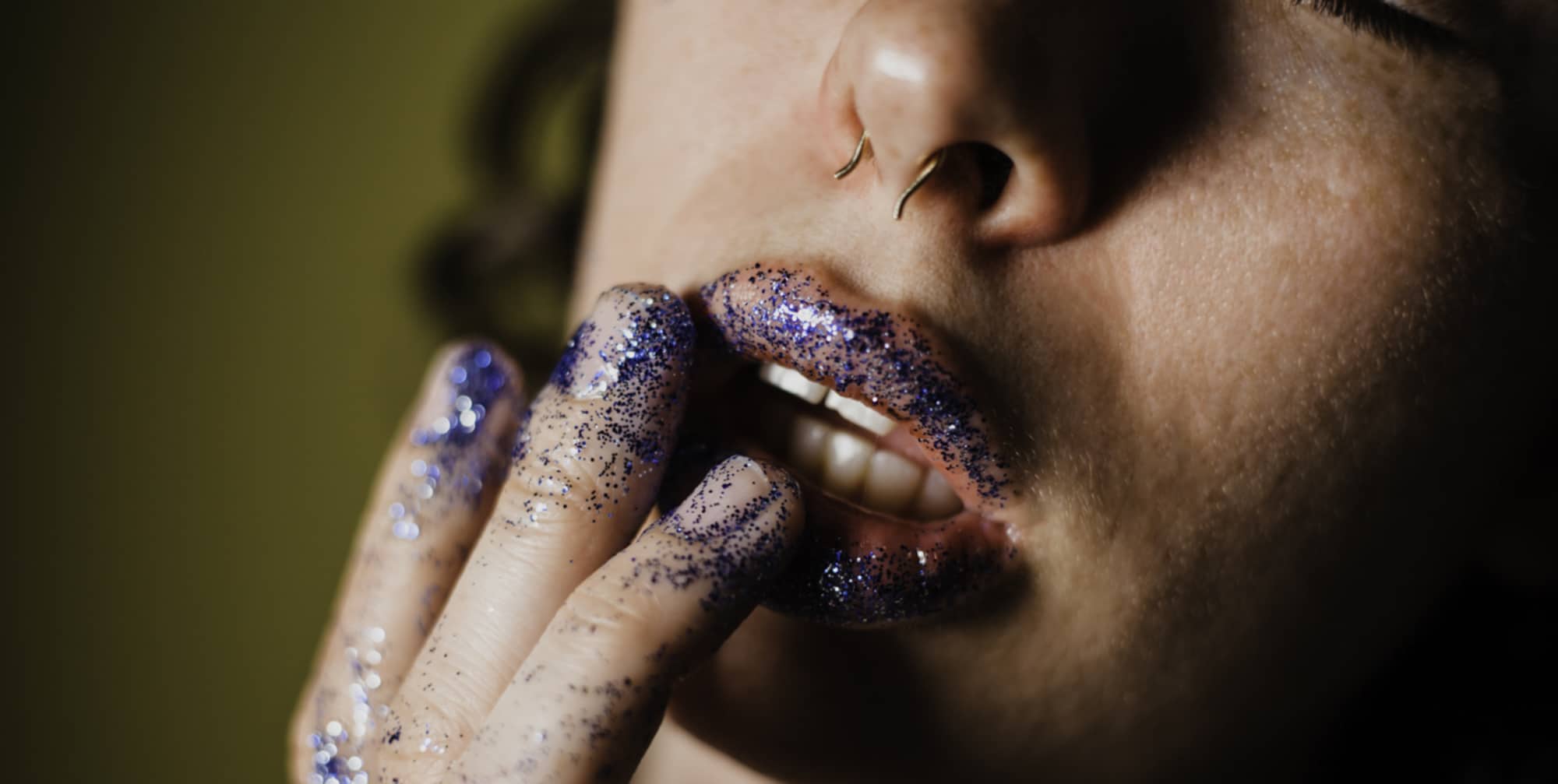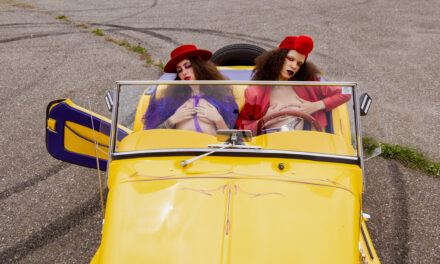Dearly beloved, we are gathered here today to mourn the departure of one of humankind’s most loyal companions: porn. Porn is dead and we killed it. More precisely, we killed its aesthetics. We killed the art of pornography.
Think about it: Instead of feeding and perpetuating desire and sexual tension, porn is now the means to repress them. Without desire, art becomes a stranger and aesthetics is an illegal alien in the land of pleasure.
Even for perverts like us here at Mundane, sex needs meaning. Just like any other form of aesthetics, sex and sexuality yearn for meaning to express their power and significance. Even getting off on your own or having a little“me” time, to put it more delicately, must be a meaningful experience, otherwise, you’re just wasting your time, as well as something way more precious…
Since humanity is condemned to repeat its mistakes when ignorant of the past, we asked Dr. Edward George, seasoned cunnilinguist, to draft for us a history of the aesthetics of porn, starting from our ancestors to the contemporary age. Vastly known for proving the existence of the “Gräfenberg Spot”, pornography and sex is his native tongue, no pun intended.
It may not bring porn back to life, but perhaps it may give us all something to think about before our next sexual soliloquy.
Luca Di Fabio – Founder & Editor-in-Chief, Mundane Magazine
The Aesthetics of Pornography in the 20th Century – Part 1
By Dr. Edward George
The naked woman was once beautiful. An image feared and revered in societies of the past. Today she is ubiquitous… but lifeless. No longer taboo… and no longer meaningful, either.
This fall from grace is the great mystery of the 20th century – a century that saw the consummation of a millennia-long flirtation between sex and technology. A century that saw the birth of the American Dream and with it, the American Fantasy.
The Dream defies definition but the Fantasy is made manifest in sexual imagery. Erotica. Pornography. Just as sex generates humanity, the tension between human desire and human limitations generates art, culture, and life. Every creation walks this tightrope, but none more deftly than pornography – the product of technology, sex, and society. In between the legs of that triskelion, the aesthetic of the form emerges.
Now the 20th Century – the American Century – is over. Technology is infinite. Sex is insignificant. Society is alienating. Unrestrained progress eased the vital tension that once existed and the tightrope lies limp. Art is pornographic but pornography is no longer art. Just lifeless and soulless sex replicated to infinity. Long after leaving the womb, the American Fantasy has eaten its twin.
How did it happen? Why did it happen?
What remains of the American Fantasy?
These are the questions we endeavor to answer in this three-part series.
But first, nudes.
Ancient Nudes
Bleeding edge technology has been a vehicle for pornography into antiquity. Back in 1994, when society was first cutting its teeth on the newfangled World Wide Web, John Tierney nicely aggregated this history in the pages of the New York Times, calling porn“theLow-Slung Engine of Progress”
Sometimes the erotic has been a force driving technological innovation; virtually always, from Stone Age sculpture to computer bulletin boards, it has been one of the first uses for a new medium.
Tierney’s prophetic article cited examples of this interplay from French cave paintings to ancient Sumerian poetry to the Gutenberg printing press.
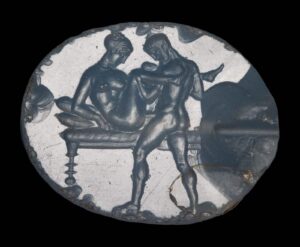
While advancing technology provides the progressive force for humans to depict the sexual in ever more evocative ways, Tierney also notes the conservative object placed in its path by censorship… the limitation that created the tension necessary for the work to come alive.
A book of erotic engravings depicting lovemaking positions, published in 1524 and suppressed by the Pope,[emphasisadded] inspired a collection of sonnets by the first modern pornographer, an Italian named Aretino.
The imagery alone does not inspire – it was the tension created by the infallible suppression of the engraving. Aretino walked this timeless tightrope, pulled taught between two pillars.
The first pillar: sexuality.
The same primal flame that burned in the hearts of those engravers and Sumerian poets and French cave painters and every other hotblooded creature that’s ever walked this Earth.
The second pillar: limitations.
The technology that limited Aretino to the written word and the engravers to engravings.
The codes of acceptability upheld by the moral arbiter of the age.
The mortal nature of humanity.
This tension is art’s throughline in our history. And the runup to this past century was no different.
The Second Industrial Revolution released many of the constraints on art and imagery that had long stifled man’s ability to depict what spews forth from his mind and his heart and his soul and his balls. New technology became a vehicle for erotica… but the limitations on the form remained tight.
Louis Daguerre was one of those legendary inventors who put his name right in his invention. The daguerreotype was the first publicly available form of photography, introduced to the world in 1839.
It was immediately used for nudes.
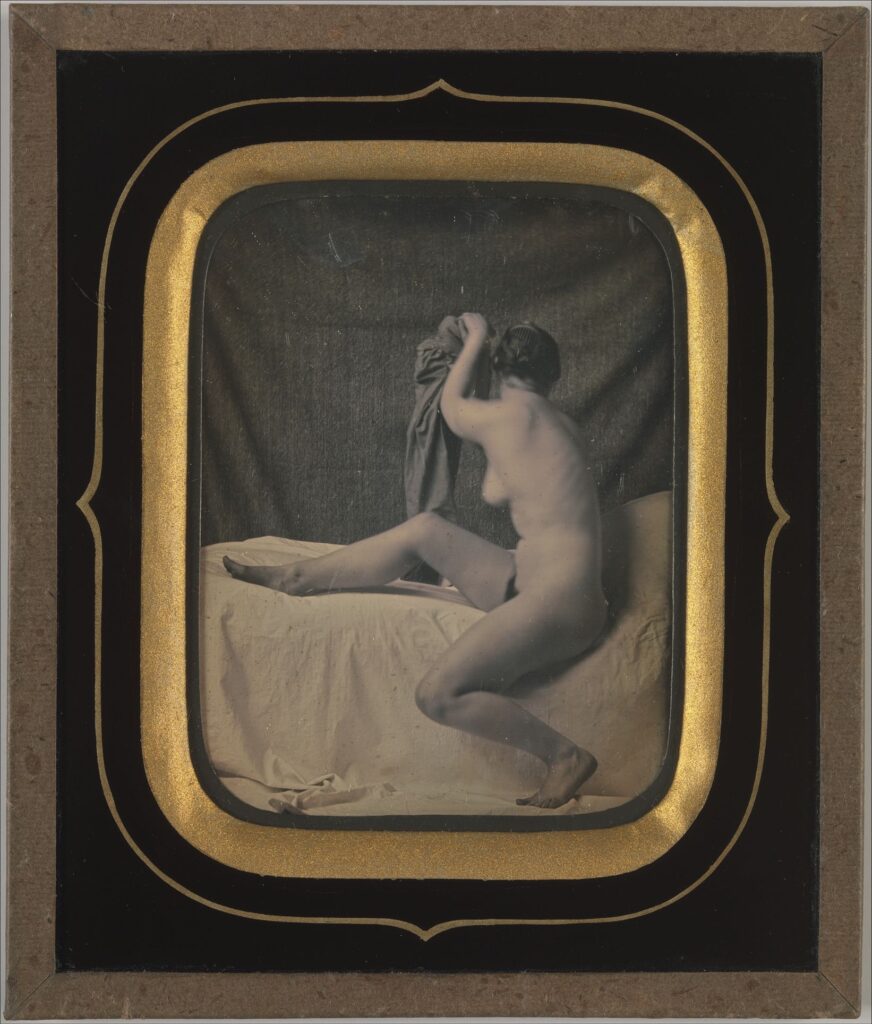
A technological leap forward… though not without limits. To be sold on the open market, each nude had to be registered with the French government following an approval process. Daguerre had created the most coveted desk job in the history of the French bureaucracy – and his wondrous invention saw hyper-realistic sexual imagery(relative to the technology of the time) printed and sold as“drawing aids” to painters.
Photography pioneer and vengeance cuckold Eadweard Muybridge was a leader in the early field of motion studies, definitively documenting the nature of a horse’s gallop for the first time in human history.
Occasionally the object of his studies was a nude woman.
But Muybridge’s nudes were acceptable because of the scientific nature of his studies and the fact they were holding baskets and fishing poles.
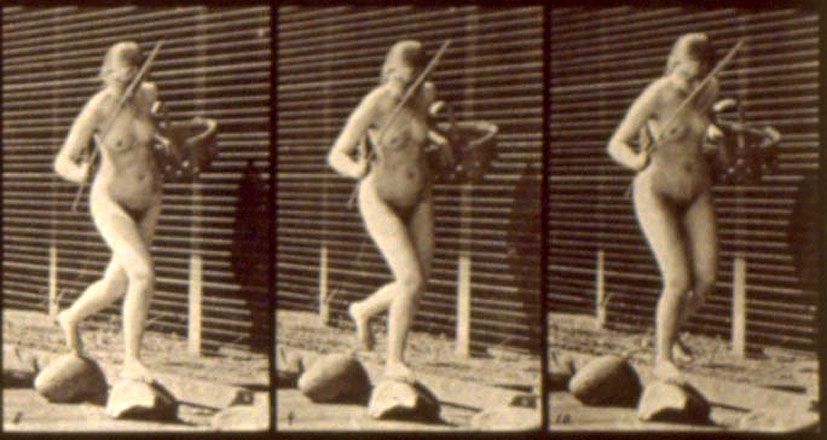
Mass production of photography finally exploded when the humble William Fox Talbot patented the calotype process, declining to name it after himself. The mass production of pornography followed soon behind.
A look back at the wealth of far more indecent Victorian Erotica suggests the infamous societal mores of the time contributed to a surprisingly kinky brand of pornography. Could the kink exist without the mores?
The 20th Century is an experiment that tests that hypothesis.
The 1920s – Mechanical Imagery
Early photography revolutionized the static nude. The pretense of censorship on artistic merit eventually fell away and an entire industry of “FrenchPostcards” became massively popular on both sides of the Atlantic. The postcards were unfit for postage – they weren’t even legal in the United States. Instead, they were distributed for consumption via street vendors, newsboys, and tobacconists.
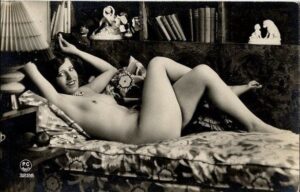
The women photographed may have been beautiful, exotic, and topless but the cards were greater than the sum of their voluptuous parts. They struck a chord pulled taught between the twin pillars of unbridled sexual imagery and the bridal of respectability. Infamous French sensuality constrained by these limitations of the new medium and the clandestine distribution network. From this tension, the image is made art.
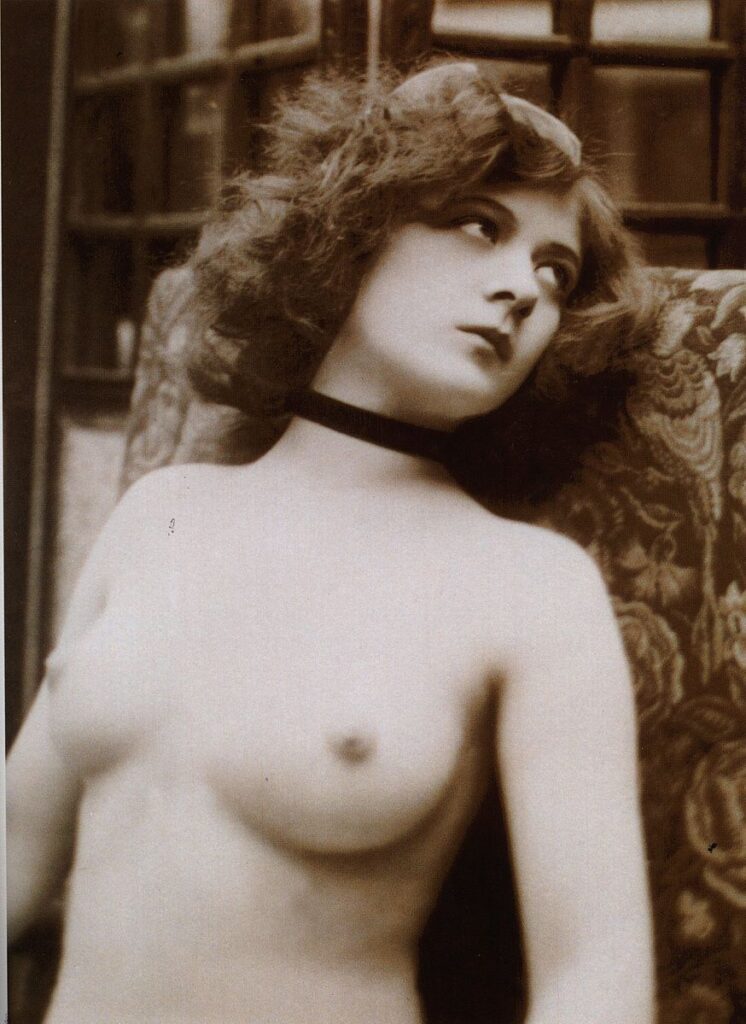
This period revolutionized the consumption of new erotic media. With the 35 mm”candid” camera, the gates of creation were opened, as well. Hobbyists like Monsieur X accidentally invented the amateur genre that proliferates the Internet today. But technology is a beast that does not remain still. Moving pictures began to capture the imagination of the American public… and breathe life into the American Fantasy.
The first Stag Film is roughly dated to 1915. It’s called “AFree Ride” and it’s as hardcore as anything in the dregs of Pornhub today. The film silently depicts a man picking up two women in his motorcar and fucking the both of them.
I’m going your way, and I’ll be nice
Nearly a century before Bang Bros’ gonzo-style autobus erotica revolutionized their medium, making them“the standard by which we compare all other[pornsites]”, the pseudonymous duo A. Wise Guy and Will B. Hard invented the bit.

The genre took off in the 1920s as film technology became more accessible for both creation and consumption. Much like the underground infrastructure for imported French nudes, Stag producers relied on a distribution network uniquely decentralized into small communities to avoid the censure of society. As noted in VICE,
Entrepreneurs, likely with the aid of organized crime, shot the films around the nation, then trafficked them to towns where masculine communal organizations like the Elks, Legionnaires, Rotarians, or college frats would host“stag parties,” chipping in to host screenings in which they’d all watch hardcore sex together. It was a solid business model—so solid producers saw no need to innovate for decades, ossifying a silent, chaotic, and colorless style.
This communal aspect has been lost to technological progress and the societal changes in tow, as pornography – and communities – have moved online. And though silence, chaos, and gray-tone may have worked for the Stag genre, the industry forming on the sunny streets of Los Angeles desired sound, order, and technicolor. Yes, Hollywood was finding its legs.
The 1930’s – The Battle for Hollywood
Like its technological predecessors, the talking motion picture was immediately taken into the throes of the erotic. The war over the moral limitations that would be applied to new mediums waged on.
After initially enumerating an ignored list of”Don’ts” and “Be Careful”, the Motion Picture Association of America and its president Will H. Hays expanded upon that list to enshrine the Motion Picture Production Code, commonly referred to as“theHays Code” in a total Daguerre move.
The Code itself was drafted by Father Daniel Lord and Martin Quigley, moved by the effect they felt the talkies could have on impressionable youth and a general outlook grounded in Catholic teachings.
But Hollywood laughed off the Code. They were living in a new age. An age without limits.
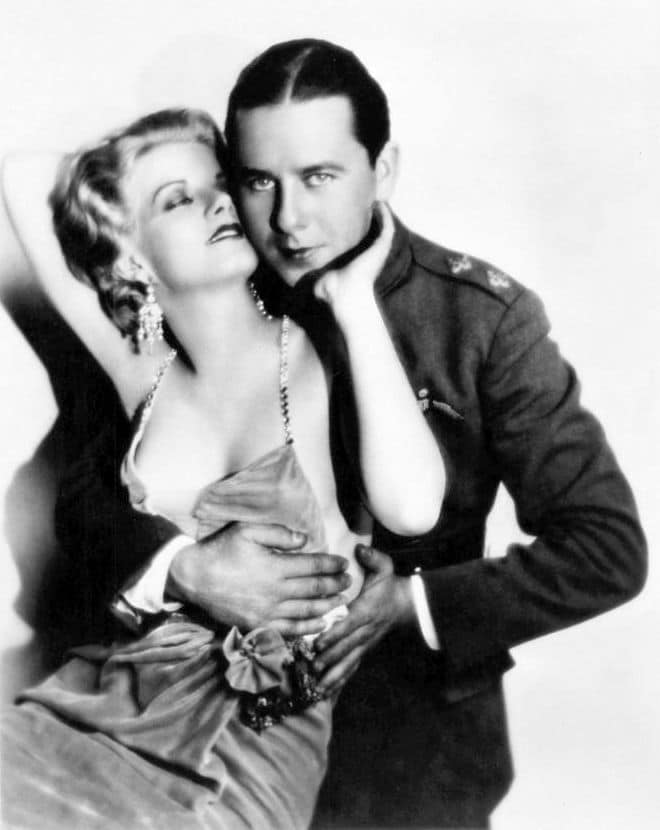
The first half of the decade saw Cecile B. Demille’s The Sign of the Cross feature a lesbian dance scene and a naked women attacked by crocodiles and a gorilla; Baby Face depicted Barbara Stanwyck’s Nietzschian quest to fuck her way to the top of the corporate ladder at a big New York bank; Scandalous promotional material pushed the Code even further than the films, most infamously with the very nude Joan Blondell on a poster for Three on a Match.

Sitting on a chair backward has always been edgy.
When Joseph Breen took over the new Production Code Administration in 1934, he began to strictly enforce the Code. As Vox recently complained, the Catholics won this battle for the morality of Hollywood. The Catholics would not win the war…
Did the Code eliminate sexual imagery from Hollywood? Far from it. Instead, it applied the limitations of Catholic moral teachings to the libido of the new medium, creating the tension from which modern cinema was born. Director Edward Dmytryksaid that the Code
had a very good effect because it made us think. If we wanted to get something across that was censorable… we had to do it deviously. We had to be clever. And it usually turned out to be much better than if we had done it straight.
This point is exemplified in the work of director Ernst Lubitsch and his famous “Lubitsch Touch.”
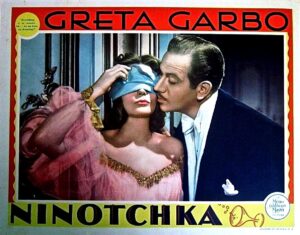
Though Lubitsch may have had the“touch” before the Hays Code came into effect, he would come to be known as the master of that delicate balance between the suggested and the depicted that the Code propped up. The opening scene in The Merry Widow (1934) is pure “Touch”- it depicts a King discovering his Lieutenant having an affair with his Queen. A classic trope. A truly human story. And Lubitsch, as film critic Ray Durgnat put it, told the story“through ellipse and emphasis.”
So the audience remains outside of the royal bedroom as
- The King leaves
- The Lieutenant sees the King left, and enters
- The King, having forgotten his sword and belt, returns
- The(rather large) King then emerges with sword and belt…
- …only to discover it is the sword and belt of a much skinnier man!
This is exactly where the viewer should be. Not in the Bedroom. Not with the King. But in the tension between.
Watch the scene and watch Billy Wilder describe it.
Lubitsch created the aesthetic of modern Hollywood – the medium that proved crucial to manifestation of the American Fantasy. Rather than a pure suggestion or pure depiction, Lubitsch operated in the space between the two. The same space exists between the projector and the screen. This space is occupied by the audience. Watching. Experiencing. Light beaming from the creator’s mind into the depths of the viewer’s imagination.
The 1940’s – Pinned on the Western Front
When every able-bodied man in the West was shipped into the carnage of World War II, the still image necessarily returned to vogue. There was no access to the cinema at the front. There was no projector, no screen, no space in between. There were no women, either.
Enter the Pinup Girl.
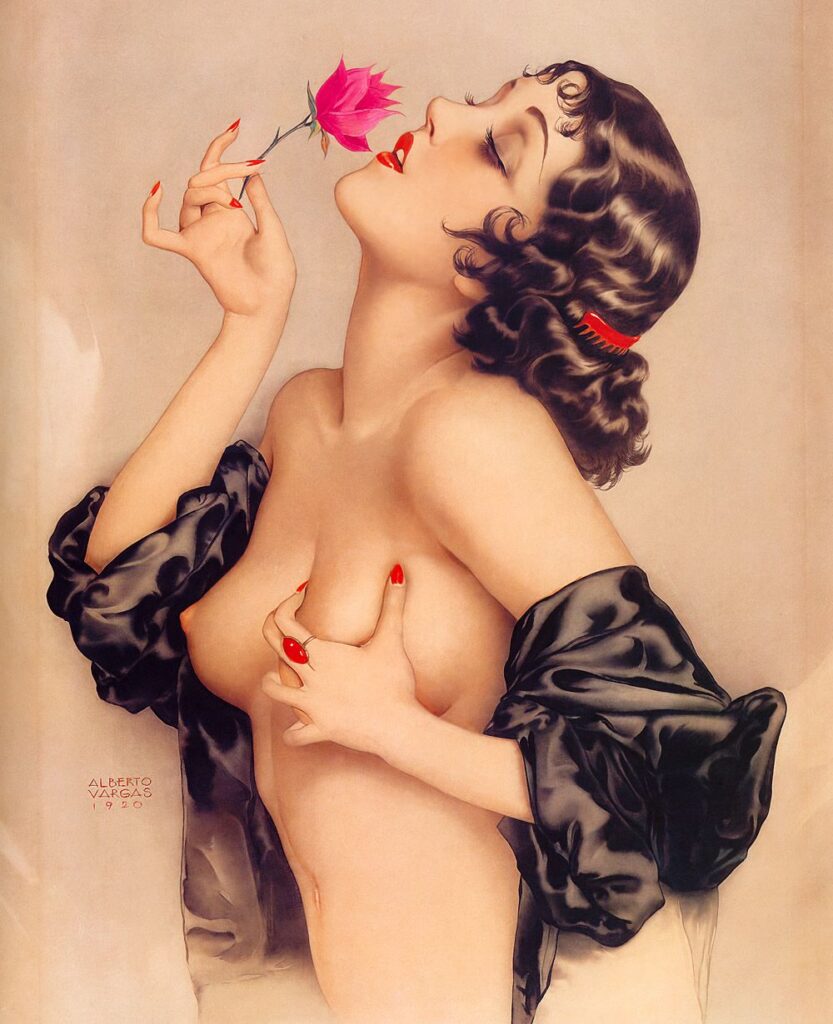
Men have been drawing idealized women since the first time an opposable thumb gripped prehistoric charcoal. Esquire magazine had been printing idealized women since its inception in 1932. But with the nation at war, their nudes took on a different tone. Not the ideal woman for a man in society but the ideal woman for man in hell.
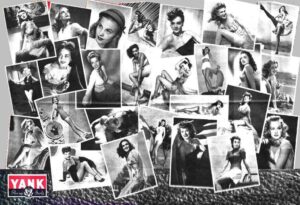
Peruvian immigrant and proud naturalized citizen Alberto Vargas stands out with his famous ‘VargaGirls,’ which grew more patriotic after the war broke out. As his biographer Carol Holstead notes,
In his Varga Girls, Vargas depicted an idealized version of the American woman. The Varga Girl had eggshell skin, long limbs, and breasts that defied gravity. She was both sensual and wholesome.[emphasis added]
With the world in a state of self-destruction, unprecedented limitations were placed on the life-generating force of nature. An island in the east would be atomized. A continent in the west would be leveled. Hundreds of millions would die. Our civilization might never truly recover. For those that lived through those dark times, the light shone in the pages of Esquire.
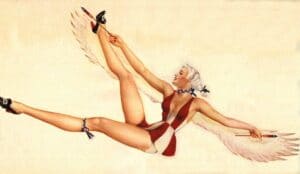
The magazine became a sensation – so much so that it caught the eye of the print media’s Code-keepers: the US Post Office. Though the USPS lost a court case accusing the magazine of mailing obscene material, Esquire dialed back on Vargas’ depictions of the“idealized American beauty.” But the blooming of the American Fantasy would not be stopped. The pearl-clutching Post Office wasn’t just mailing Varga girls to the front… Hollywood was airdropped in, as well.
By far the most popular cheesecake photos were those of the starlets. When peace reigned, the men had sat in a theater – in between the projector and the screen – and fallen in love for 90 minutes at a time. Now their fantastical sweethearts were with them in war
Jane Russell was plucked from obscurity by Howard Hughes during casting for The Outlaw in 1941. On the strength of her two considerable talents, she got the part. The film was censored by the Hays Code until 1950 but promotional stills were pinned to barracks up and down both fronts. They could suppress the film but they couldn’t suppress Jane Russell’s magnificent rack.
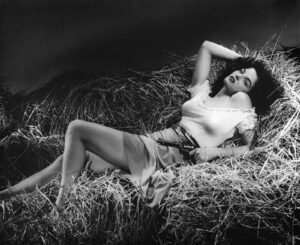
Even more popular was Rita Hayworth, who the US Navy dubbed “TheRed-Head We Would Most Like to be Ship-Wrecked with” – her famous pinup from the promotional material for You’ll Never Get Rich was too risque for the cover of LIFE but sold more than 5 million copies before the war was through.
The only pinup that sold more than was Betty Grable’s. Her stems may have single-highhandedly inspired the Allied forces to victory over the Axis powers. From Time:
The men took Betty wherever they went, tacking her poster to barrack walls, painting her on bomber fuselages and fastening 2-by-3 prints of her next to their hearts.
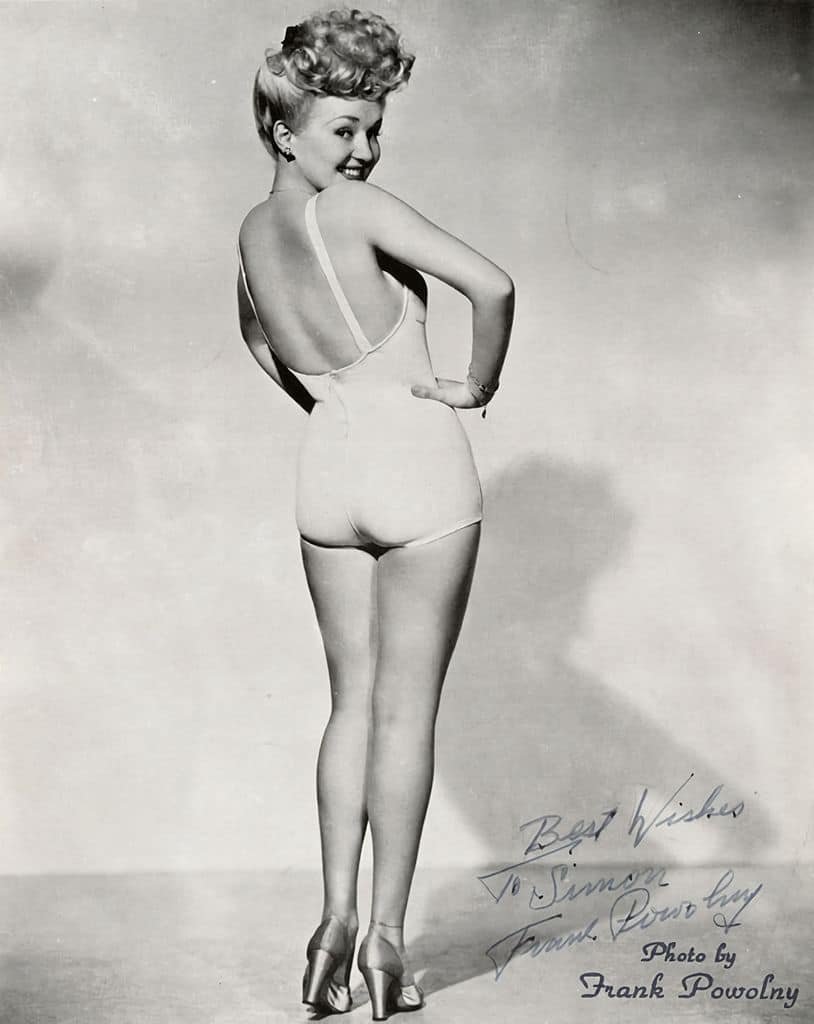
The Pinup captured the American Fantasy at a time when the American Dream – indeed all of the Western Civilization – was in peril. The tension between sex and death was paramount. The natural engine of human life against man-made engines of death. The Dream and the Fantasy – both were palpable in the illustrations and photographs this lost generation kept in their breast pockets. Palpable in the averted gaze of the Varga Girl, the ample bosom of Jane Russell and perky smile of Betty Grable.
Grable, though, was a mere John the Baptist to the messiah Norma Jean.
She would be known to the world as Marilyn Monroe.
She was the American Fantasy made flesh.

More on the Marilyn and the Golden Age of Pornography in American Fantasy – Part II.


